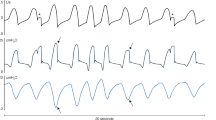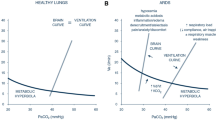Abstract
Bronchomotor and ventilatory responses to inhalation of cigarette smoke (50% concentration, 6 ml) were studied in anesthetized and vagotomized Sprague-Dawley rats. Low-nicotine cigarette smoke did not cause any detectable delayed response, whereas high-nicotine cigarette smoke induced rapid, shallow breathing, and a marked increase in airway resistance (RL). The increase in f reached a peak (Δf=43±8%) at the 5th breath after the onset of smoke inhalation, preceding both the decrease in VT (ΔVT=−27±4%) and the increase in RL (ΔRL=89±19%); the latter 2 reached their peaks at approximately the 10th breath, displaying a similar temporal pattern of responses between them. The bronchomotor response to high-nicotine cigarette smoke was slightly attenuated but not prevented by prior administration of isoproterenol (0.2 mg/kg, intravenously [iv]), nor was the smoke-induced rapid, shallow breathing. In contrast, prior administration of mecamylamine (0.9 mg/kg, iv) completely abolished both the bronchomotor and ventilatory responses to smoke inhalation, indicating that nicotine is the primary causative agent responsible for these changes.
Similar content being viewed by others
References
Benner JF (1970) Tentative summary of leaf and smoke analysis of the University of Kentucky reference and alkaloid series cigarettes. In: Proc. Univ. Kentucky Tobacco Health Res. Inst. Tobacco Health Conf., pp 30–32
Coleridge HM, Coleridge JCG (1986) Reflexes evoked from tracheobronchial tree and lungs. In: Cherniack NS, Widdicombe JG (eds) Handbook of physiology. Am Physiol Soc, Washington, DC, Sec 3, Vol 2, Part 1, Chapt 12, pp 395–429
Comroe JH Jr, Mortimer L (1964) The respiratory and cardiovascular responses to temporally separated aortic and carotid bodies to cynide, nicotine, phenyldiguanide and serotonin. J Pharmacol Exp Ther 146:33–41
Griffith RB, Hancock R (1985) Simultaneous mainstream-sidestream smoke exposure system. I. Equipment and procedures. Toxicology 34:123–128
Hartiala J, Mapp C, Mitchell RA, Shields RL, Gold WM (1984) Cigarette smoke-induced bronchoconstriction in dogs: vagal and extravagal mechanisms. J Appl Physiol 57:1261–1270
Hartiala JC, Mapp C, Mitchell RA, Gold WM (1985) Nicotine-induced respiratory effects of cigarette smoke in dogs. J Appl Physiol 59:64–71
Hawkins DF, Paton WDM (1958) Responses of isolated bronchial muscle to ganglionically active drugs. J Physiol (Lond) 144:193–219
Kizawa Y, Takayanagi I (1985) Possible involvement of substance P immunoreactive nerves in the mediation of nicotine-induced contractile responses in isolated guinea pig bronchus. Eur J Pharmacol 113:319–323
Kou YR, Lee L-Y (1991) Mechanisms of cigarette smoke-induced stimulation of rapidly adapting receptors in canine lungs. Respir Physiol 83:61–76
Lee L-Y, Kou YR, Frazier DT, Beck ER, Pissari TE, Coleridge HM, Coleridge JCG (1989) Stimulation of vagal pulmonary C-fibers by a single breath of cigarette smoke in dogs. J Appl Physiol 66:2032–2038
Lee L-Y, Morton RF, Kou YR (1990) Acute effects cigarette smoke on breathing in rats: vagal and nonvagal mechanisms. J Appl Physiol 68:955–961
Lee L-Y, Morton RF, Fang L-B (1990) Neonatal capsaicin pretreatment abolishes bradypneic and bronchoconstrictive responses to inhaled cigarette smoke and nicotine injection in rats. FASEB J 4(4):A951
Lee L-Y (1990) Inhibitory effect of gas phase cigarette smoke on breathing: role of hydroxyl radical. Respir Physiol 82:227–238
Lundberg JM, Saria A (1987) Polypeptide-containing neurons in airway smooth muscle. Annu Rev Physiol 40:557–572
Mead J, Whittenberger JL (1953) Physical properties of human lungs measured during spontaneous respiration. J Appl Physiol 5:779–796
Mead J, Coolier C (1959) Relationship of volume history of lungs to respiratory mechanics in anesthetized dogs. J Appl Physiol 14:669–678
Mitchell RA, Loeschcke HH, Massion WH, Severinghaus JW (1963) Respiratory responses mediated through superficial chemosensitive areas on the medulla. J Appl Physiol 18:523–533
Nadel JA, Widdicombe JG (1962) Effect of changes in blood gas tensions and carotid sinus pressure on tracheal volume and total lung resistance to airflow. J Physiol (Lond) 163:13–33
Nadel JA, Comroe JH Jr (1961) Acute effects of inhalation of cigarette smoke on airway conductance. J Appl Physiol 16:713–716
Otis AB, McKerrow CB, Bartlett RA, Mead J, McIlroy MB, Selverstone NJ, Radford EP (1956) Mechanical factors in distribution of pulmonary ventilation. J Appl Physiol 8:427–443
Skoogh BE (1988) Airway parasympathetic ganglia. In: Kaliner MA, Barnes PJ (eds) The airways: neural control in health and disease. Marcel Dekker, New York, pp 217–240
Taylor RF, Lee L-Y, Jewell LA, Frazier DT (1986) Effect of nicotine aerosol on slowly adapting receptors in the airways of the dog. J Neurosci Res 15:583–593
Weissberg RM, Marian J, Bradshaw J, Alvarez R (1977) Differences in pulmonary and cardiovascular beta receptors in the guinea pig and rabbit. J Pharmacol Exp Ther 202:337–345
Yu LKH, Lee L-Y, Frazier DT (1984) Effects of bronchoconstriction on breathing during normoxia and hypoxia in anesthetized cats. Respir Physiol 57:31–45
Author information
Authors and Affiliations
Rights and permissions
About this article
Cite this article
Fang, LB., Morton, R.F., Wang, A.L. et al. Bronchoconstriction and delayed rapid shallow breathing induced by cigarette smoke inhalation in anesthetized rats. Lung 169, 153–164 (1991). https://doi.org/10.1007/BF02714151
Accepted:
Issue Date:
DOI: https://doi.org/10.1007/BF02714151




